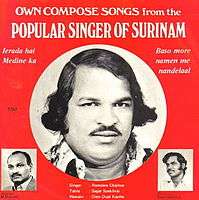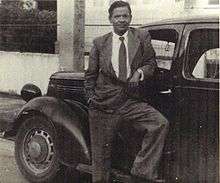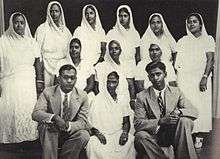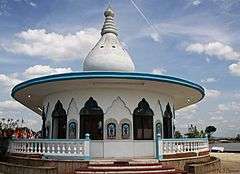Indo-Caribbean
| |||||||||||||||||||||||||||||||||||||
| Total population | |||||||||||||||||||||||||||||||||||||
|---|---|---|---|---|---|---|---|---|---|---|---|---|---|---|---|---|---|---|---|---|---|---|---|---|---|---|---|---|---|---|---|---|---|---|---|---|---|
| 2 million + | |||||||||||||||||||||||||||||||||||||
| Regions with significant populations | |||||||||||||||||||||||||||||||||||||
| 464,500 | |||||||||||||||||||||||||||||||||||||
| 327,000 | |||||||||||||||||||||||||||||||||||||
| 148,000 | |||||||||||||||||||||||||||||||||||||
| 100,000 | |||||||||||||||||||||||||||||||||||||
| 60,000 | |||||||||||||||||||||||||||||||||||||
| 43,600 | |||||||||||||||||||||||||||||||||||||
| 21,500 | |||||||||||||||||||||||||||||||||||||
| 19,276 | |||||||||||||||||||||||||||||||||||||
| 12,000 | |||||||||||||||||||||||||||||||||||||
| 7,000 | |||||||||||||||||||||||||||||||||||||
| 4,700 | |||||||||||||||||||||||||||||||||||||
| 4,500 | |||||||||||||||||||||||||||||||||||||
| 3,000 | |||||||||||||||||||||||||||||||||||||
| 2,200 | |||||||||||||||||||||||||||||||||||||
| 1,200 | |||||||||||||||||||||||||||||||||||||
| 1,100 | |||||||||||||||||||||||||||||||||||||
| 800 | |||||||||||||||||||||||||||||||||||||
| 732+ | |||||||||||||||||||||||||||||||||||||
| 600 | |||||||||||||||||||||||||||||||||||||
| 300 | |||||||||||||||||||||||||||||||||||||
| 258 | |||||||||||||||||||||||||||||||||||||
| 200 | |||||||||||||||||||||||||||||||||||||
| 100 | |||||||||||||||||||||||||||||||||||||
| 40 | |||||||||||||||||||||||||||||||||||||
| Languages | |||||||||||||||||||||||||||||||||||||
|
Colonial Languages: Indian Languages: | |||||||||||||||||||||||||||||||||||||
| Religion | |||||||||||||||||||||||||||||||||||||
|
Predominantly: Minority: | |||||||||||||||||||||||||||||||||||||
| Related ethnic groups | |||||||||||||||||||||||||||||||||||||
|
| |||||||||||||||||||||||||||||||||||||
Indo-Caribbeans are Caribbean people with roots in India. They are mostly descendants of the original indentured workers brought by the British, the Dutch and the French during colonial times.
The term East Indian is used in the English-speaking Caribbean and by the Canadian mainstream media. They are sometimes simply called Indian, Hindustani, Jahaji, Girmitya, Coolie, Kantraki, Bharatiya, Desi, or India Wale, in the English-speaking Caribbean.
Most Indo-Caribbean people live in the English-speaking Caribbean nations, Suriname, and the French overseas departments of Guadeloupe and Martinique, with smaller numbers in other Caribbean countries and, following further migration, in Europe and North America.
Sub-groups
Caribbean Islands
- Indians in Barbados
- Indian community in the Dominican Republic
- Indo-Haitians
- Indo-Grenadians
- Indians in Guadeloupe
- Indo-Martiniquais
- Indo-Jamaican
- Indo-Saint Lucian
- Indo-Trinidadian and Tobagonian
- Indo-Vincentian
Mainland Caribbean
Diaspora
- Indo-Caribbean Americans
- British Indo-Caribbean community
- Indians in French Guiana
- Indians in Venezuela
- Indians in Argentina
- Indians in Colombia
- Indians in Panama
- Indians in Brazil
- Indians in Peru
Migration history

From 1838 to 1917, over half a million Indians from the former British Raj or British India and Colonial India, were taken to thirteen mainland and island nations in the Caribbean as indentured workers to address the demand for sugar cane plantation labour following the abolition of slavery. Attempts at importing Portuguese, Chinese and others as indentured labourers had failed.
Sugarcane plantations in the 19th century
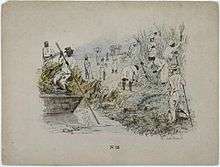
Much like cotton, sugarcane plantations motivated large scale near-enslavement and forced migrations in the 19th and early 20th century.[1]
Following the emancipation of slaves in 1833 in the United Kingdom, many liberated Africans left their former masters. This created an economic chaos for British owners of sugar-cane plantations in the Caribbean region, and elsewhere. The hard work in hot, humid farms required a regular, docile and low-waged labour force. The British looked for cheap labour. Since slavery had been abolished, the British crafted a new legal system of forced labour, which in many ways resembled enslavement.[2] Instead of calling them slaves, they were called indentured labourers. Indians, primarily began to replace Africans previously brought as slaves, under this indentured labour scheme to serve on sugarcane plantations across the British empire.
The first ships carrying indentured labourers for sugarcane plantations left India in 1838 for the Caribbean region. In fact, the first two shiploads of Indians arrived in British Guiana (now Guyana) on May 5, 1838 on board the Whitby and Hesperus. These ships had sailed from Calcutta. In the early decades of the sugarcane-driven migrations, indentured Indians were treated as inhumanely as the enslaved Africans had been. They were confined to their estates and paid a pitiful salary. Any breach of contract brought automatic criminal penalties and imprisonment. Many of these were brought away from their homelands deceptively. Many from inland regions over a thousand kilometers from seaports were promised jobs, were not told the work they were being hired for, or that they would leave their homeland and communities. They were hustled aboard the waiting ships, unprepared for the long and arduous four-month sea journey. Charles Anderson, a special magistrate investigating these sugarcane plantations, wrote to the British Colonial Secretary declaring that with few exceptions, the indentured labourers are treated with great and unjust severity; plantation owners enforced work in sugarcane farms so harshly, that the decaying remains of immigrants were frequently discovered in sugarcane fields. If labourers protested and refused to work, they were not paid or fed: they simply starved.[1]
The sugarcane plantation-driven migrations led to ethnically significant presence of Indians in Caribbean.[3] In some islands and countries, these Indo-Caribbean migrants now constitute a significant proportion of the population. Sugarcane plantations and citizens of Indian origin continue to thrive in countries such as Guyana, formerly, British Guiana, Jamaica, Trinidad and Tobago, Martinique, French Guiana, Guadeloupe, Grenada, St. Lucia, St. Vincent, St. Kitts, St. Croix, Suriname and Nevis.[1][4] By some estimates, over 2.5 million people in the Caribbean are of Indian origin. Many have ethnically blended with migrants from other parts of the world, creating a unique syncretic culture.
Though production was centered in the Caribbean, sugarcane production played a significant role in pre-World War II global politics and population movements. France, for example, negotiated with Britain leading to Act XLVI of 1860, whereby large numbers of Indian indentured labourers were brought for harsh sugarcane plantation work in French colonies in the Caribbean region.[5] The Caribbean colonies of the Netherlands too benefitted from the indentured laborers from India.
Post World War II trends

The majority of the Indians living in the English-speaking Caribbean came from eastern Uttar Pradesh and western Bihar, while those brought to Guadeloupe and Martinique were largely from Andhra Pradesh and Tamil Nadu. About twenty percent (20%) of the indentured were Tamils and Telugus particularly in Trinidad and Tobago, and Guyana.
A minority emigrated from other parts of South Asia, including present-day Pakistan and Bangladesh.
Indo-Caribbeans comprise the largest ethnic group in Guyana, Suriname and Trinidad and Tobago.
They are the second largest group in Jamaica, Grenada, Saint Vincent and the Grenadines, Saint Lucia, Martinique and Guadeloupe.
There are also small communities in Anguilla, Antigua and Barbuda, The Bahamas, Barbados, Belize, French Guiana, Panama, Dominican Republic and the Netherlands Antilles. Small groups also exist in Haiti, where they are sometimes mistakenly referred to as "mulattos".
Modern-day immigrants from India (mostly Sindhi merchants) are to be found on Saint-Martin / Sint Maarten, St. Thomas, Curaçao and other islands with duty-free commercial capabilities, where they are active in business. Other Indo-Caribbean people descend from later migrants, including Indian doctors, Gujarati businessmen and migrants from Kenya and Uganda.
Indo-Caribbeans have migrated to the United States, Canada, Hispanic America (notably Panama, Colombia, Argentina, Peru, and Venezuela), Brazil, the Netherlands, Spain, France and the United Kingdom, and to other parts of the Caribbean.
Culture

The indentured Indians and their descendants have actively contributed to the evolution of their adopted lands in spite of many difficulties. Indo-Caribbean culture consists of a synthesis of Indian, Creole, Afro Caribbean (African), and Western European influences from historical colonizing powers.
Commemoration
In recent years, attempts to commemorate the Indian presence and contributions have come to fruition:
Indian Arrival Day is a holiday celebrated on May 30 in Trinidad and Tobago each year since the 1990s. It was first celebrated in Trinidad and Tobago and then other countries with significant Indian people who's ancestors came as indentured laborers. It commemorates the first arrivals from Akhand Bharat (the Indian subcontinent) to Trinidad and Tobago, on May 30, 1845, on the ship Fatel Razack
In 1995, Jamaica started to celebrate the arrival of Indians in Old Harbour Bay, St. Catherine Parish on May 13.
In 2003, Martinique celebrated the 150th anniversary of Indian arrival. Guadeloupe did the same in 2004. These celebrations were not the fact of just the Indian minority, but the official recognition by the French and local authorities of their integration and their wide-scale contributions in various fields including agriculture, education, and politics, and to the diversification of the culture of the Creole peoples. Thus, the noted participation of the whole multi-ethnic population of the two islands were in these events.
St. Lucia and many Caribbean countries have dedicated commemorative days to acknowledge the arrival and important contributions of their Indo-Caribbean populations. St. Lucia celebrates its Indo-Caribbean heritage on May 6. Other dates when India Arrival Day is celebrated in the Caribbean include May 5 (Guyana), May 10 (Jamaica), May 30 (Trinidad and Tobago), June 1 (St. Vincent), and June 5 (Suriname).[4]
Indo Caribbean media - Canada
There are three Indo-Caribbean newspapers based in Toronto:
- Indo-Caribbean World - has been in existence for 25 years
- Caribbean Xpress - has been in existence for five years
- Indo-Caribbean Times - existed for about two years; ceased publication after the death of one its founding members in April 2010
Notable Canadian Indo Caribbeans
- Anjulie - singer/songwriter; her parents migrated from Guyana
- Dave Baksh - lead guitarist of the band Sum 41; a founding member of the mainly reggae band Brown Brigade; his parents migrated from Guyana
- Bas Balkissoon - born in Trinidad and Tobago, a member of the Provincial Parliament of the Province of Ontario
- Neil Bissoondath - writer, born in Trinidad and Tobago
- Melanie Fiona - R&B singer and songwriter, born to Guyanese parents; also of Afro-Caribbean descent
- Hedy Fry - long-standing Canadian federal politician and physician, born in San Fernando, Trinidad and Tobago; fifth person to ever unseat a sitting prime minister (1993)
- Kamala-Jean Gopie - educator and political activist; (Jamaican born)
- Ian Hanomansing - born in Trinidad and Tobago, a television anchor and reporter with the Canadian Broadcasting Corporation (CBC)
- Shani Mootoo - writer, born in Ireland to Trinidadian parents
Other notable Indo Caribbeans
- Tatyana Ali - American actress and R&B singer; also of Afro-Caribbean descent
- Jacques Bangou - incumbent mayor of Pointe-à-Pitre, Guadeloupe
- Shivnarine Chanderpaul - current West Indies cricketer and former captain of the side; from Guyana
- Rhona Fox - Guyanese-born actress in Hollywood
- Shivana Jorawar - legal advocate, women's reproductive health activist
- Bhadase Sagan Maraj - Trinidadian Hindu activist and founder of the Sanatan Dharma Maha Sabha
- Nicki Minaj - Trinidadian rapper and songwriter; also of Afro-Caribbean descent
- V. S. Naipaul - writer, born in Trinidad, Nobel Prize in Literature (2001)
- Nicole Narain - Guyanese-American model and actress; also of Afro-Caribbean descent
- Kamla Persad-Bissessar - Seventh Prime Minister of Trinidad and Tobago
- Deborah Persaud - AIDS researcher
- Sundar Popo - Father of Chutney music
- Ravi Rampaul-present cricketer of West Indies cricket team from Trinidad and Tobago( The first fast bowler in West Indies cricket team of Indian descent)
See also
- Hinduism in the West Indies
- Biharis
- Tamil diaspora
- Indo-Caribbean music
- British Indo-Caribbean community
- Indo-Caribbean Americans
- Anglophone Caribbean
- Coolitude
- dhantal
References
- 1 2 3 "Forced Labour". The National Archives, Government of the United Kingdom. 2010.
- ↑ Hugh Tinker (1993). "New System of Slavery". Hansib Publishing, London. ISBN 978-1-870518-18-5.
- ↑ K Laurence (1994). "A Question of Labour: Indentured Immigration Into Trinidad & British Guiana, 1875-1917". St Martin's Press. ISBN 978-0-312-12172-3.
- 1 2 "St. Lucia's Indian Arrival Day". Caribbean Repeating Islands. 2009.
- ↑ "Indian indentured labourers". The National Archives, Government of the United Kingdom. 2010.
External links
| Wikimedia Commons has media related to Indian diaspora in the Caribbean. |
- Indo-Caribbean Alliance, Inc. - a 501(c)3 non-profit organization providing services and advocacy to New York City's growing Indo-Caribbean community
- Jahajee Sisters: Empowering Indo-Caribbean Women - a movement-building organization, led by Indo-Caribbean women, committed to fighting gender-based violence and advocating for reproductive justice. Jahajee Sisters fosters solidarity and empowerment through dialogue, arts, leadership development and grassroots organizing.





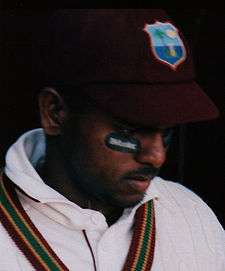







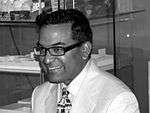


.jpg)


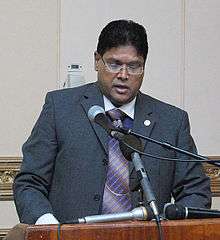

.jpg)
